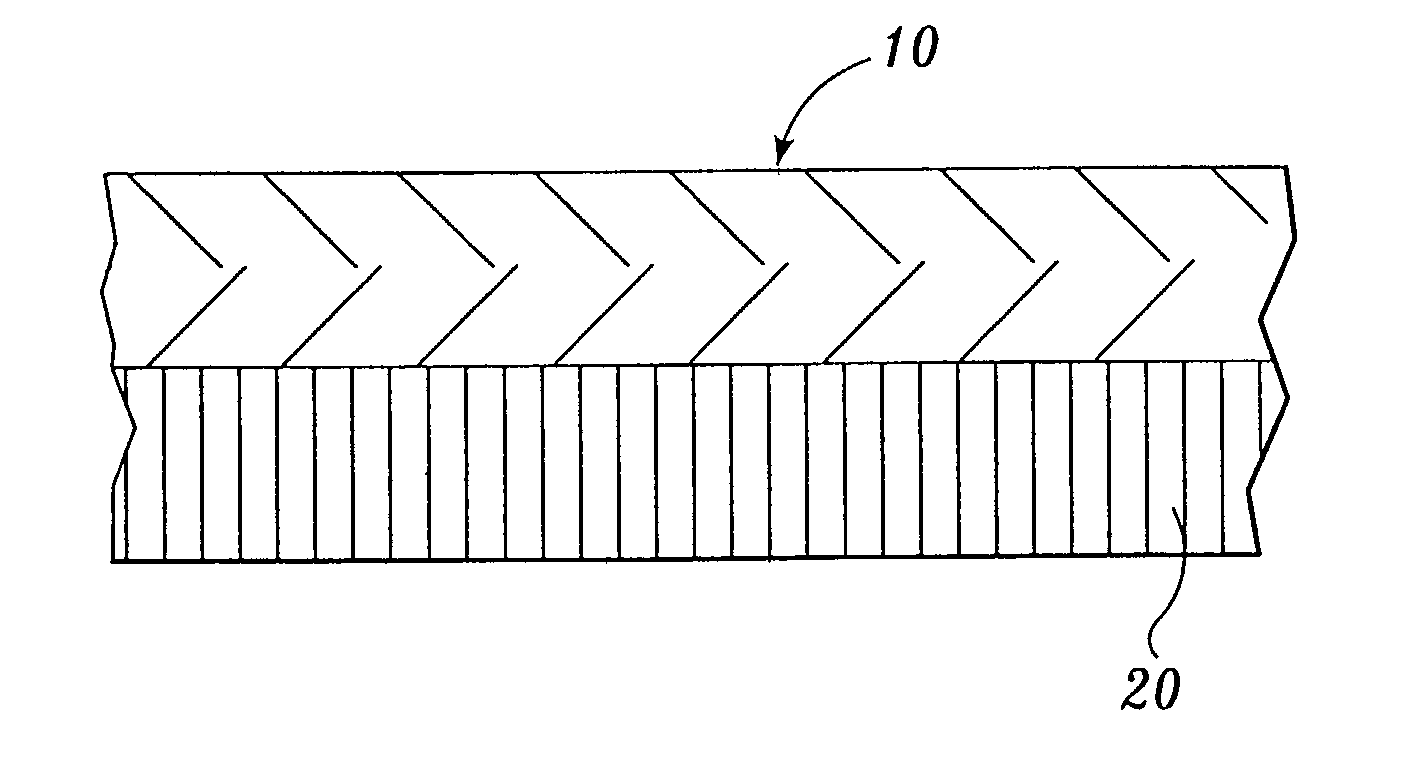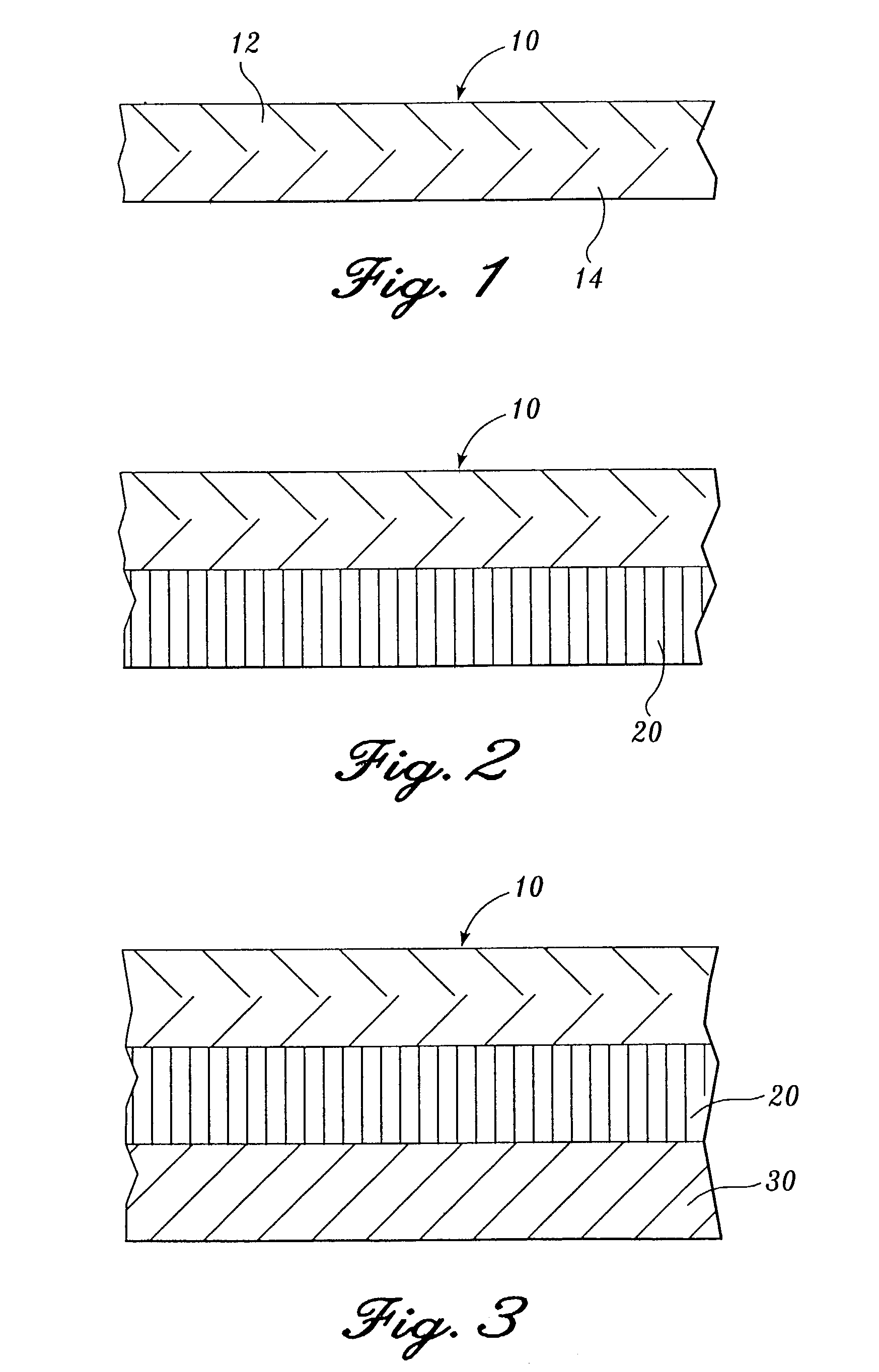Unitary stratified composite
a composite material and unitary technology, applied in the field of absorbent composites, can solve the problems of suffer from liquid leakage and rewetting, and hygienic products that contain only a high-thickness nonwoven acquisition layer suffer from a lack of fast temporary liquid storage capability and leakag
- Summary
- Abstract
- Description
- Claims
- Application Information
AI Technical Summary
Benefits of technology
Problems solved by technology
Method used
Image
Examples
example 1
Unitary Stratified Composite Formation: Wet Laid Method
[0087]This example illustrates a wet laid method for forming a representative unitary stratified composite of the present invention. In this example, the absorbent composite has a first stratum composed of 90% polyethylene terephthalate (fiber length 0.5 inches, 15 denier, crimped) (Hoechst Celanese Co.) and 10% Celbond® T-105 (Hoechst Celanese Co.), and a second stratum composed of a 90% crosslinked cellulose fiber (Weyerhaeuser Co.) and 10% Celbond® T-105.
Fiber Preparation
[0088]A lab size Waring blender was filled with 4 L of water and Celbond® T-105 (for the first stratum) was added. The mixture was blended for a short time to “open” the synthetic fibers. The polyethylene terephthalate (PET) fibers were then added to the Celbond® T-105 / water mixture and blended for at least one minute to “open” the PET fibers and to effect mixing of the two synthetic fibers. The resulting aqueous mixture of fibers contained approximately 0.02...
example 2
Unitary Stratified Composite Formation: Air Laid Method
[0092]This example illustrates an air laid method for forming a representative unitary stratified composite of the present invention. In this example, the absorbent composite has a first stratum composed of 90% polyethylene terephthalate (fiber length 0.5 inches, 15 denier, crimped) (Hoechst Celanese) and 10% Celbond® T-105 (Hoechst Celanese), and a second stratum composed of a 90% crosslinked cellulose fiber (Weyerhaeuser Co.) and 10% Celbond® T-105.
Fiber Preparation
[0093]PET fibers and Celbond® T-105 for the first stratum were placed in a plastic bag and thoroughly mixed with an airstream. Crosslinked cellulose fibers and Celbond+T-105 for the bottom stratum were placed in a second plastic bag and mixed thoroughly with an airstream.
Sheet Formation
[0094]A pinmill was used to “open” the fibers. The resulting fibers were then evenly distributed on a tissue by first slowly metering the crosslinked cellulose fiber-Celbond® T-105 mi...
example 3
Unitary Stratified Composite Formation: Laboratory Foam Method
[0096]This example illustrates a laboratory foam method for forming a representative unitary stratified composite of the present invention. The absorbent composite has a first stratum composed of 90% polyethylene terephthalate (fiber length 0.5 inches, 15 denier, crimped) (Hoechst Celanese) and 10% Celbond® T-105 (Hoechst Celanese), and a second stratum composed of a 90% crosslinked cellulose fiber (Weyerhaeuser Co.) and 10% Celbond® T-105.
Fiber Preparation
[0097]The fibers were prepared as for the wet laid process described above in Example 1. The crosslinked cellulose fiber-Celbond® T-105 mixture was placed in a container and water added to form an aqueous mixture. The resulting mixture was then blended for a few seconds with an air-entrapping blade. A surfactant (Incronan 30, Croda, Inc.) was added to the blended mixture. Approximately 1 g active surfactant solids per gram fiber were added. The mixture was blended while...
PUM
| Property | Measurement | Unit |
|---|---|---|
| length | aaaaa | aaaaa |
| length | aaaaa | aaaaa |
| density | aaaaa | aaaaa |
Abstract
Description
Claims
Application Information
 Login to View More
Login to View More - R&D
- Intellectual Property
- Life Sciences
- Materials
- Tech Scout
- Unparalleled Data Quality
- Higher Quality Content
- 60% Fewer Hallucinations
Browse by: Latest US Patents, China's latest patents, Technical Efficacy Thesaurus, Application Domain, Technology Topic, Popular Technical Reports.
© 2025 PatSnap. All rights reserved.Legal|Privacy policy|Modern Slavery Act Transparency Statement|Sitemap|About US| Contact US: help@patsnap.com



